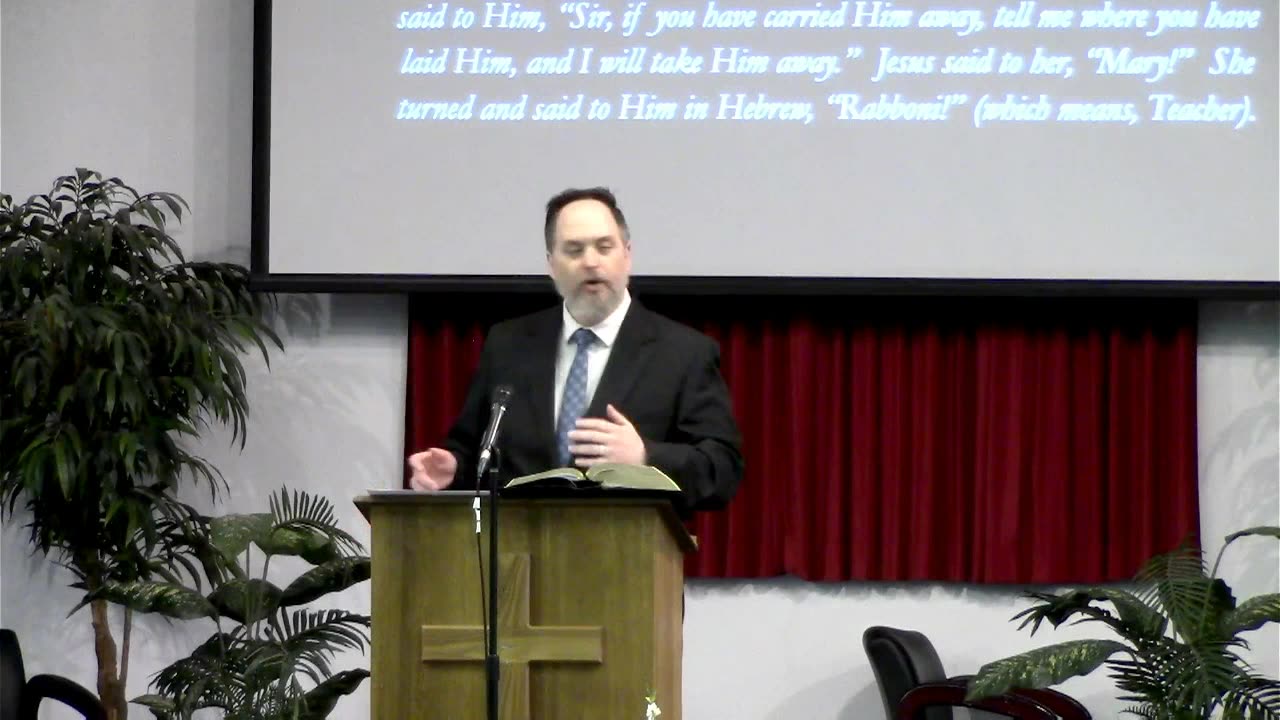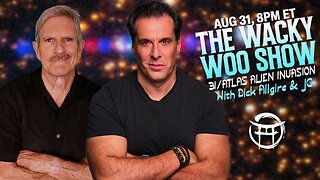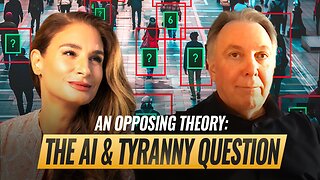Premium Only Content

“The Resurrected Jesus Appears” (John 20:11–18)
For the first time in history, someone walks out of the grave and shows Himself alive. Why does John spend time with Jesus's first appearance?
-Notes: https://pastormarksbury.blogspot.com/2025/06/sermon-resurrected-jesus-appears-john.html
-Livestream: https://lwbcfruita.org/live
-Donations: https://www.lwbcfruita.org/give
MANUSCRIPT:
Series: “John: Life in Christ’s Name” #105
Text: John 20:11–18
By: Shaun Marksbury
Date: June 1, 2025
Venue: Living Water Baptist Church
Occasion: AM Service
I. Introduction
Last week, we noted that the resurrection of Christ is one of the most pivotal moments in human history. It follows the creation of the world and the fall of man. It follows the revelation of God’s law at Sinai. It follows the incarnation and perfect life of our Lord under the Law. And it follows His crucifixion and burial. Yet, with the resurrection, we see a turning point back to what was lost in the Garden of Eden as well as hope for new life.
We only considered what the disciples did last time, the surprise of the empty tomb. We noted how this evidence points us to the truth of the matter, though. For instance, the Apostle John is not afraid to include details which would prove embarrassing for His Gospel account. As one commentary notes,
In a patriarchal society where a woman’s testimony to the resurrection of Jesus would not be valued highly (cf. the way women’s statements were regarded in Luke 24:11, 24–25; Acts 12:15), the length of this story in the evangelist’s selection of materials is rather striking. … It is further significant when one notes that J. Klausner categorized Mary Magdalene as “a woman who had suffered from hysterics to the verge of madness.”[1]
The evidence is so clear that this is testimony, not fantasy, that various people have tried to explain away the veracity of these accounts. For instance, some have suggested that the grief of all the parties involved was so great that they must have hallucinated the resurrected Jesus. MacArthur records another theory that tries to get around the account: One
academic liberal, Kirsopp Lake, argued that the women mistakenly went to the wrong tomb (even though two of them had watched Jesus being buried; Mark 15:47). Finding it empty, they erroneously assumed that Jesus had risen from the dead. But that means that Peter and John must have also gone to the wrong tomb. And surely Joseph of Arimathea and Nicodemus, who buried Jesus, knew which tomb they had put His body in. Obviously the Jewish leaders also knew which tomb was the right one, since they had sealed it and posted a Roman guard outside of it. Why did someone not simply go to the right tomb and produce Jesus’ body?[2]
Unless a person has already decided this is false and refuses to believe it, there is no other conclusion than the bodily resurrection of our Lord Jesus Christ! In this passage, we see Mary Magdalene, a devoted follower of Christ, weeping outside the tomb. She’s consumed by grief and confusion — not expecting a resurrection. Yet, in her sorrow, she encounters the risen Lord, an encounter that changes her forever.
We should also allow belief to change us. This morning, we’ll see three clear reasons to believe in the bodily resurrection of our Lord: First, angels call us to belief. Second, Jesus Himself calls us to belief. Third, witnesses call us to belief. Let’s dive into this text, verse by verse, and discover how it speaks to us today.
II. First, Angels Call Us to Belief (vv. 11–13)
But Mary was standing outside the tomb weeping; and so, as she wept, she stooped and looked into the tomb; and she saw two angels in white sitting, one at the head and one at the feet, where the body of Jesus had been lying. And they said to her, “Woman, why are you weeping?” She said to them, “Because they have taken away my Lord, and I do not know where they have laid Him.”
Let’s begin by considering Mary Magdalene’s grief. The passage opens with her Magdalene standing outside the tomb, weeping. She remains there despite the inspection of Peter and John in the previous verses (vv. 3–10). While the disciples examined the tomb and left, perhaps she returned slowly to the spot they had ran to, only to find them already gone.[3]
She was overwhelmed by her sorrow. We might think of her weeping as a quiet sobbing, but the term is used of loud, unrestrained lamentation. That was typical of mourners in that culture, and her cries are hardly an affectation. She was lost in deep grief, what we might today call a depressive episode. Mary is consumed by the loss, not only for Jesus’s death, but also now believing His body has been stolen.
Grief is a natural human response to loss, and we must acknowledge its place in our lives. Yet, as believers, we are called not to linger in despair but to cling to the promises of God. Mary’s sorrow blinds her to the hope standing just before her, a reminder that our emotions, while valid, can sometimes obscure God’s truth.
Yet, in God’s providence, she apparently decides to do an investigation of her own. However, as she looks into the tomb through tear-filled eyes, she doesn’t notice the grave clothes Peter and John examined. Rather, two angels capture her attention!
We read about these angels in v. 12 as wearing all white and sitting at the head and at the feet of where the body of Jesus had been lying. They were not present when Peter and John inspected the tomb earlier, suggesting a supernatural appearance. Their presence, clothed in white, is a biblical symbol of purity and holiness (cf. Dan. 7:9; Acts 1:10).[4] Their positioning, one at the head and one at the feet, evokes the imagery of the cherubim on the mercy seat (Exod. 25:18),[5] symbolizing God’s presence and the victory of Christ over death.
Of course, some have thought that this presents a contradiction in the text. Matthew mentions but one angel (Matt. 28:2), Mark records the presence of a young man (Mark 16:5), and Luke notes two men (Luke 24:4). Yet, this isn’t a contradiction; angels often appear in human form, and one may have been the primary speaker, as is common in Scripture.[6] They wouldn’t have the halos and wings that we see in pop culture.[7]
It’s not clear whether Mary herself realized these were angels, as people often fall down before them. She may have wondered if they were the ones who took Jesus’s body. Instead, these angels (a term which means “messengers”) they were there to call Mary — and us — to belief in the resurrection.
They begin by saying “woman.” Again, this is a respectful address, a term of endearment akin to “ma’am” in our context. They then ask, “Why are you weeping?” We might think that they are asking out of curiosity, but they know why. They ask, not to be callous, but to gently invite her to reflect. Her sorrow is warranted in light of the resurrection —Jesus is alive!
Mary’s response reveals her heart, though. She misses the invitation to reflect, instead answering, “Because they have taken away my Lord, and I do not know where they have laid Him.” Understand, she calls Him “my Lord,” reflecting her devotion, but her words show she still believes His body has been stolen. Her grief clouds her understanding, but the angels’ presence is the first step in calling her to belief.
Like Mary, we may face moments of grief or confusion that blind us to God’s work. When life feels empty, we must look to and believe in the promises of God. The resurrection assures us that Christ has overcome death, and His victory is ours. Let’s trust in His power, even when our eyes are filled with tears.
Unfortunately, her grief keeps her from understanding in this moment. Yet, she is about to receive a surprise which will forever change her. Let’s consider this next:
III. Second, Jesus Calls Us to Belief (vv. 14–16)
When she had said this, she turned around and saw Jesus standing there, and did not know that it was Jesus. Jesus said to her, “Woman, why are you weeping? Whom are you seeking?” Supposing Him to be the gardener, she said to Him, “Sir, if you have carried Him away, tell me where you have laid Him, and I will take Him away.” Jesus said to her, “Mary!” She turned and said to Him in Hebrew, “Rabboni!” (which means, Teacher).
Immediately, there is someone else standing there. This must have caught her attention, or she was turning to motion. Whatever the event, she then sees Jesus standing there, though she didn’t know that it was Him.
This is a profound moment. Why doesn’t she recognize Him? Several possibilities exist. Her tears may have blurred her vision, or her grief may have kept her from looking fully at His face.[8] Perhaps Jesus’s appearance was marred due to the brutal crucifixion under Pilate (cf. Isa. 52:14), or maybe it “was too dark to see clearly (v. 1).”[9] Perhaps He supernaturally prevented her recognition, as He did with the disciples on the road to Emmaus (Luke 24:16). Yet, the main reason she failed to recognize Him was because she still thought He was dead — she sought a body, not a risen Savior!
There’s much more to consider here, though. Jesus chooses to appear first to her, a woman whose testimony would have been dismissed in that. No Jewish author would invent a story with a woman — especially one with a history of demon possession (Luke 8:2) — as the first witness to the resurrection.[10] This detail underscores the historicity of the account and God’s grace in choosing the lowly to proclaim His truth (cf. 1 Cor. 1:27–29). This is again a reminder that the Gospel writers did not shy away from “embarrassing” aspects of their account.
We see another wonderful truth here in the midst of Mary’s sorrow. As Matthew Henry notes, “Christ is often near his people, and they are not aware of him.”[11] This is a reminder of Psalm 34:18, which says, “The Lord is near to the brokenhearted and saves those who are crushed in spirit.” He is there to provide both challenge and comfort.
So, Jesus speaks to Mary in v. 15, opening with the same respectful term as the angels. We might translate it, “Dear lady, why are you weeping? Whom are you seeking?” These questions mirror the angels’ words, and they show both His tender care for her grief as well as an invitation for her to recognize His promises. He doesn’t quite will for her to know it is Him yet; as one study notes, “Perhaps it was spoken with some roughness, as Joseph spoke to his brethren when he made himself strange, before he made himself known to them.”[12] He would have her grappling with His word before seeing Him.
Mary, still gripped by grief, mistakes Him for the gardener. She says, “Sir, if you have carried Him away, tell me where you have laid Him, and I will take Him away.” Her words reveal her devotion — she is willing to carry Jesus’ body herself. Yet, sadly, she still assumes He is still dead.
This misunderstanding reminds us how easily we can misinterpret God in our lives. As Matthew Henry notes, “Troubled spirits, in a cloudy and dark day, are apt to misrepresent Christ to themselves, and to put wrong constructions upon the methods of his providence and grace.”[13] When we are consumed by our circumstances, we may fail to know the nearness of the Lord.
Thankfully, He is a Lord of grace, and He grants her recognition. Everything changes when Jesus speaks her name: “Mary!” This single word pierces her grief and opens her eyes. As John MacArthur points out, this moment echoes Jesus’ teaching in John 10:27: “My sheep hear My voice, and I know them, and they follow Me.”[14] The personal call of her name reveals His identity.
Thus, Mary responds in Hebrew, “Rabboni!” This is also a term of respect, meaning “my Teacher.” The Reformation Study Bible notes that Rabboni is a lengthened form of Rabbi. The term signifies deep reverence.
Jesus knows each of our names. Whether He is calling us out of sin or deep pain, I hope you will learn to hear His voice. Like Mary, you may not recognize Him at first, but He is near, calling to you from His Holy Word. Let His presence transform your sorrow into joy, as it did for Mary.
Note that she could not be hallucinating a living Jesus, as the one liberal theory goes. She wasn’t expecting to find anything but a dead body, and that is what she voiced seeking twice. Seeing Jesus alive goes beyond her wildest imagination. Yet, she came to accept it. The question is whether others will, bringing us to the final point:
IV. Third, Witnesses Call Us to Belief (vv. 17–18)
Jesus said to her, “Stop clinging to Me, for I have not yet ascended to the Father; but go to My brethren and say to them, ‘I ascend to My Father and your Father, and My God and your God.’ ” Mary Magdalene came, announcing to the disciples, “I have seen the Lord,” and that He had said these things to her.
There is a bit of debate here as to what Jesus means when He tells her to not cling to Him; the KJV renders it “Touch me not.” Some think this means that she would somehow defile Him with her touch, that He must first present Himself to the Father. They suggest that Jesus quickly ascended to heaven after this meeting, then returning to speak with his disciples, which is why His disciples could later touch Him.
However, Scripture places great emphasis on Jesus ascension to heaven recorded in Acts 1, and John gives no indication here of a second ascension. Moreover, Matthew 28:9 says that the women did take ahold of His feet and worshiped Him. So, it is better to understand this as meaning that she should not cling or hold on to Jesus — He had more to His mission, and she had a job to do. Mary, overwhelmed with joy, likely wants to hold onto His physical presence, but Jesus gently corrects her.
So, He is commissioning her. He is reminding Mary that He is not merely a recovered man like Lazarus; He is now the resurrected Lord, whose ascension will usher in a new relationship through the Holy Spirit (cf. John 14:18–19; Acts 1:3–11). Others must know.
So, He sends her to His brethren. This is the first time Jesus calls His disciples “brethren,” a term reflecting the new relationship made possible through His death and resurrection (cf. Rom. 8:14–17; Heb. 2:10–13).[15] The message Mary is to deliver emphasizes Jesus’ ascension, a doctrine often overlooked but vital to our faith. Jesus’ ascension secures our righteousness and intercession before the Father (cf. Heb. 7:25).
The distinction in Jesus’ words — “My Father and your Father, My God and your God” — highlights His unique Sonship. He doesn’t say “our Father” and “our God.” Yet, through His work, we are united to Him as brothers and sisters. In Romans 8:29, we read, “For those whom He foreknew, He also predestined to become conformed to the image of His Son, so that He would be the firstborn among many brethren.” Because of Christ’s work and His ultimate ascension, we can have a similar relationship with the Father and with God.
So, commissioned to spread the Word, she bears witness of Christ to the disciples. She announces, “I have seen the Lord.” Some mistake this for preaching, but Jesus would not ask her to break His later Word, and that’s not the term used here. Mary is simply testifying or evangelizing, speaking about the good news of Jesus! She becomes the first witness to the resurrection, a task entrusted to her despite her past.
The disciples’ initial disbelief (Luke 24:11; Mark 16:11) again underscores the authenticity of this account. Yet, they will believe and become witnesses themselves. This reminds us that every believer is called to evangelize. You don’t need a perfect past or a platform to share the gospel; you need only share with others the Word and tell them what He has done in your life. Like Mary, let your encounter with Jesus compel you to speak the truth!
V. Conclusion
The resurrection of Jesus is not a myth or a mistake, as skeptics claim. The empty tomb, the angels’ testimony, Jesus’s appearance, and Mary’s witness all point to one undeniable truth: Christ is risen! And this calls us to look beyond what we are experiencing to God’s power in Christ.
Where are you today? Are you like Mary, consumed by your own pain and worries and doubt? Why are you weeping? Look to Jesus, who knows your name, bore your shame on the cross, and offers you forgiveness and peace. If you are a believer, I hope you will trust Him with your heartache, holding on to His promises. If He raised up from grave, then He can lift you up from where you are — just let Him change you.
--------------------------
[1] Gerald L. Borchert, John 12–21, The New American Commentary, (Nashville: Broadman & Holman Publishers, 2002), 25B:297.
[2] John F. MacArthur Jr., John 12–21, MacArthur New Testament Commentary, (Chicago, IL: Moody Publishers, 2008), 375.
[3] “She apparently had not crossed paths with Peter or John and thus did not know of Jesus’ resurrection (see v. 9).” John MacArthur Jr., Ed., The MacArthur Study Bible, electronic ed., (Nashville, TN: Word Pub., 1997), 1626.
[4] John D. Barry, Douglas Mangum, Derek R. Brown, Michael S. Heiser, Miles Custis, Elliot Ritzema, Matthew M. Whitehead, Michael R. Grigoni, and David Bomar, Faithlife Study Bible, (Bellingham, WA: Lexham Press, 2012, 2016), Jn 20:12.
[5] Matthew Henry, Matthew Henry’s Commentary on the Whole Bible: Complete and Unabridged in One Volume, (Peabody: Hendrickson, 1994), 2051.
[6] Ted Cabal, Chad Owen Brand, E. Ray Clendenen, Paul Copan, J. P. Moreland, and Doug Powell, The Apologetics Study Bible: Real Questions, Straight Answers, Stronger Faith, (Nashville, TN: Holman Bible Publishers, 2007), 1615.
[7] Edwin A. Blum, The Bible Knowledge Commentary: An Exposition of the Scriptures, 1985, 2, 342.
[8] MacArthur, The MacArthur Study Bible, 1626.
[9] Barry, et. al., Jn 20:14.
[10] Blum, 342.
[11] Henry, 2051.
[12] Ibid.
[13] Ibid.
[14] MacArthur, The MacArthur Study Bible, 1627.
[15] Ibid.
-
 1:24:08
1:24:08
Jean-Claude@BeyondMystic
11 hours ago🌀 THE WACKY WOO SHOW 3I ATLAS ALIEN INVASION with DICK ALLGIRE & JC - AUG 31 , 20254
21.2K19 -
 2:26:21
2:26:21
vivafrei
11 hours agoEp. 279: Patel's GF Sues for Defamation! Rogue Judges vs. Trump! Raja Jackson, Kick Stream & MORE!
124K54 -
 LIVE
LIVE
SpartakusLIVE
2 hours ago#1 Verdansk Sniper gets HACCUSATIONS because of INSANE Headshots
192 watching -
 18:52
18:52
Colion Noir
8 hours agoCourt Rules You Don't Need AR-15s For Self Defense, Mayor's Message If You Love Kids Ban AR-15s
10.7K43 -
 1:56:25
1:56:25
Nerdrotic
4 hours ago $1.92 earnedThe Mysteries of Mars and the Moon with Mike Bara | Forbidden Frontier #114
20.7K4 -
 1:11:31
1:11:31
The Mel K Show
2 hours agoMel K & Chas Holloway | An Opposing Theory: The AI & Tyranny Question | 8-31-25
18K3 -
 LIVE
LIVE
Rallied
2 hours ago $1.26 earnedSolo Challenges All Day
158 watching -
 LIVE
LIVE
IsaiahLCarter
2 days agoGrandmasters and Heretics || APOSTATE RADIO #027
63 watching -
 3:03:40
3:03:40
Barry Cunningham
7 hours agoPRESIDENT TRUMP IS THE TROLLER-IN-CHIEF AND MORE BREAKING NEWS!
40.7K33 -
 13:07
13:07
Robbi On The Record
4 hours ago $1.90 earnedSweet Poison: The Big Fat Lie That’s Killing America
25.1K9